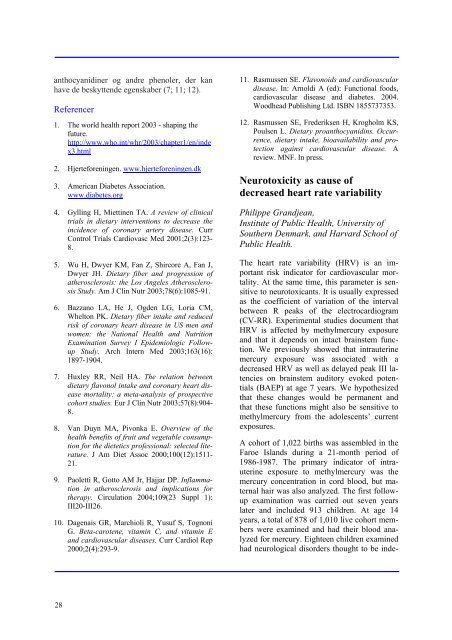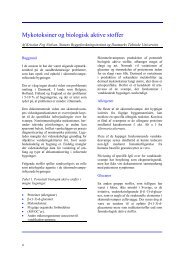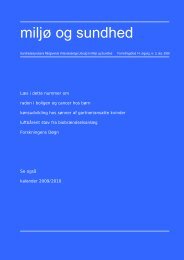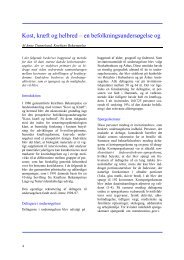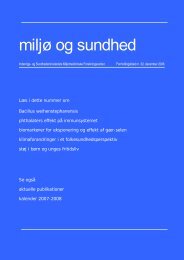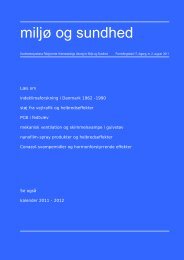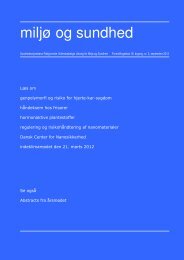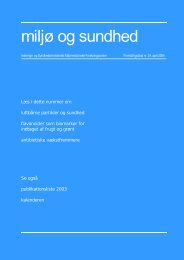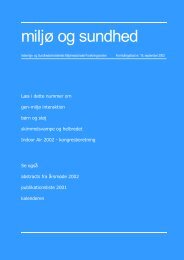Kvartære ammoniumforbindelser - Sundhedsstyrelsens Rådgivende ...
Kvartære ammoniumforbindelser - Sundhedsstyrelsens Rådgivende ...
Kvartære ammoniumforbindelser - Sundhedsstyrelsens Rådgivende ...
Create successful ePaper yourself
Turn your PDF publications into a flip-book with our unique Google optimized e-Paper software.
anthocyanidiner og andre phenoler, der kan<br />
have de beskyttende egenskaber (7; 11; 12).<br />
Referencer<br />
1. The world health report 2003 - shaping the<br />
future.<br />
http://www.who.int/whr/2003/chapter1/en/inde<br />
x3.html<br />
2. Hjerteforeningen. www.hjerteforeningen.dk<br />
3. American Diabetes Association.<br />
www.diabetes.org<br />
4. Gylling H, Miettinen TA. A review of clinical<br />
trials in dietary interventions to decrease the<br />
incidence of coronary artery disease. Curr<br />
Control Trials Cardiovasc Med 2001;2(3):123-<br />
8.<br />
5. Wu H, Dwyer KM, Fan Z, Shircore A, Fan J,<br />
Dwyer JH. Dietary fiber and progression of<br />
atherosclerosis: the Los Angeles Atherosclerosis<br />
Study. Am J Clin Nutr 2003;78(6):1085-91.<br />
6. Bazzano LA, He J, Ogden LG, Loria CM,<br />
Whelton PK. Dietary fiber intake and reduced<br />
risk of coronary heart disease in US men and<br />
women: the National Health and Nutrition<br />
Examination Survey I Epidemiologic Followup<br />
Study. Arch Intern Med 2003;163(16):<br />
1897-1904.<br />
7. Huxley RR, Neil HA. The relation between<br />
dietary flavonol intake and coronary heart disease<br />
mortality: a meta-analysis of prospective<br />
cohort studies. Eur J Clin Nutr 2003;57(8):904-<br />
8.<br />
8. Van Duyn MA, Pivonka E. Overview of the<br />
health benefits of fruit and vegetable consumption<br />
for the dietetics professional: selected literature.<br />
J Am Diet Assoc 2000;100(12):1511-<br />
21.<br />
9. Paoletti R, Gotto AM Jr, Hajjar DP. Inflammation<br />
in atherosclerosis and implications for<br />
therapy. Circulation 2004;109(23 Suppl 1):<br />
III20-III26.<br />
10. Dagenais GR, Marchioli R, Yusuf S, Tognoni<br />
G. Beta-carotene, vitamin C, and vitamin E<br />
and cardiovascular diseases. Curr Cardiol Rep<br />
2000;2(4):293-9.<br />
11. Rasmussen SE. Flavonoids and cardiovascular<br />
disease. In: Arnoldi A (ed): Functional foods,<br />
cardiovascular disease and diabetes. 2004.<br />
Woodhead Publishing Ltd. ISBN 1855737353.<br />
12. Rasmussen SE, Frederiksen H, Krogholm KS,<br />
Poulsen L. Dietary proanthocyanidins. Occurrence,<br />
dietary intake, bioavailability and protection<br />
against cardiovascular disease. A<br />
review. MNF. In press.<br />
Neurotoxicity as cause of<br />
decreased heart rate variability<br />
Philippe Grandjean,<br />
Institute of Public Health, University of<br />
Southern Denmark, and Harvard School of<br />
Public Health.<br />
The heart rate variability (HRV) is an important<br />
risk indicator for cardiovascular mortality.<br />
At the same time, this parameter is sensitive<br />
to neurotoxicants. It is usually expressed<br />
as the coefficient of variation of the interval<br />
between R peaks of the electrocardiogram<br />
(CV-RR). Experimental studies document that<br />
HRV is affected by methylmercury exposure<br />
and that it depends on intact brainstem function.<br />
We previously showed that intrauterine<br />
mercury exposure was associated with a<br />
decreased HRV as well as delayed peak III latencies<br />
on brainstem auditory evoked potentials<br />
(BAEP) at age 7 years. We hypothesized<br />
that these changes would be permanent and<br />
that these functions might also be sensitive to<br />
methylmercury from the adolescents’ current<br />
exposures.<br />
A cohort of 1,022 births was assembled in the<br />
Faroe Islands during a 21-month period of<br />
1986-1987. The primary indicator of intrauterine<br />
exposure to methylmercury was the<br />
mercury concentration in cord blood, but maternal<br />
hair was also analyzed. The first followup<br />
examination was carried out seven years<br />
later and included 913 children. At age 14<br />
years, a total of 878 of 1,010 live cohort members<br />
were examined and had their blood analyzed<br />
for mercury. Eighteen children examined<br />
had neurological disorders thought to be inde-<br />
28


